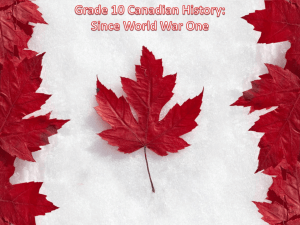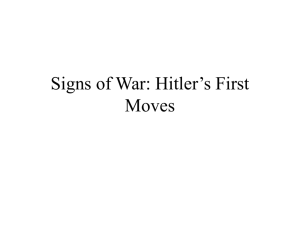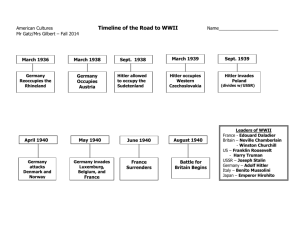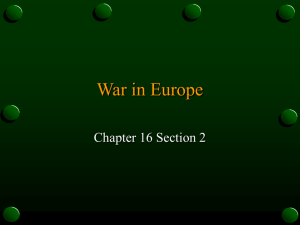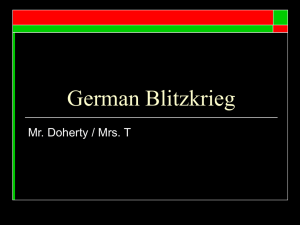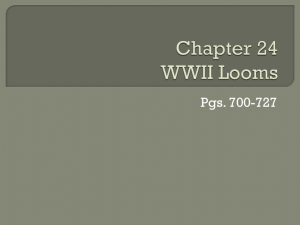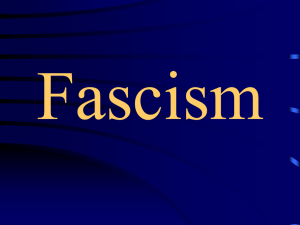Lesson 6 – The fall of Poland and France
advertisement
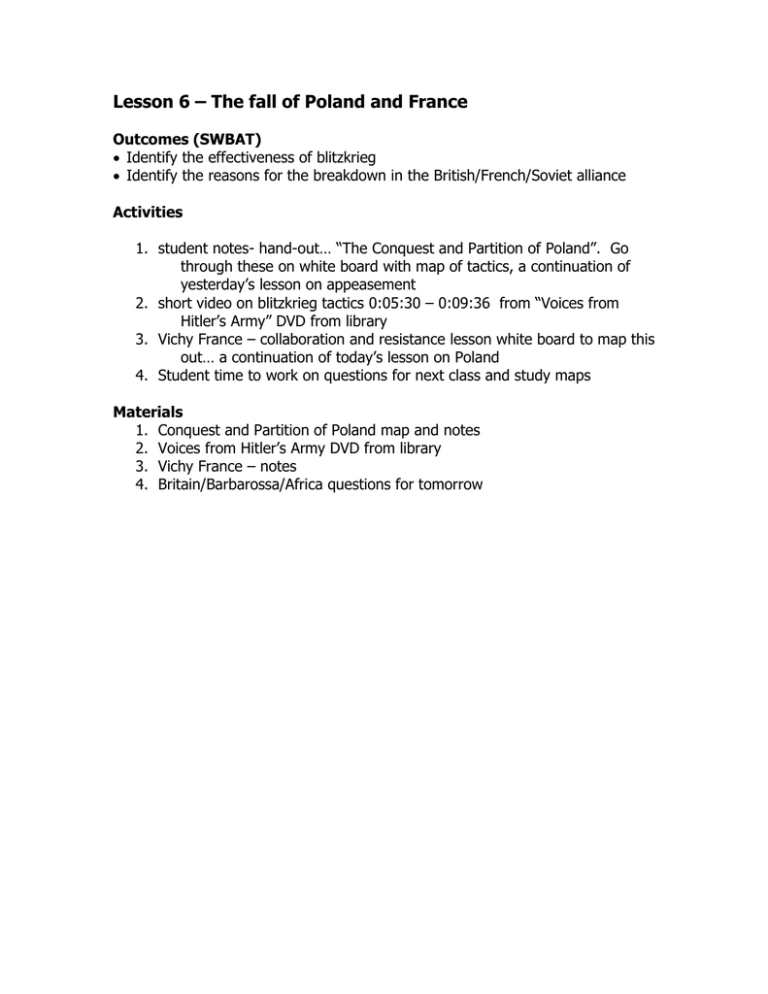
Lesson 6 – The fall of Poland and France Outcomes (SWBAT) Identify the effectiveness of blitzkrieg Identify the reasons for the breakdown in the British/French/Soviet alliance Activities 1. student notes- hand-out… “The Conquest and Partition of Poland”. Go through these on white board with map of tactics, a continuation of yesterday’s lesson on appeasement 2. short video on blitzkrieg tactics 0:05:30 – 0:09:36 from “Voices from Hitler’s Army” DVD from library 3. Vichy France – collaboration and resistance lesson white board to map this out… a continuation of today’s lesson on Poland 4. Student time to work on questions for next class and study maps Materials 1. Conquest and Partition of Poland map and notes 2. Voices from Hitler’s Army DVD from library 3. Vichy France – notes 4. Britain/Barbarossa/Africa questions for tomorrow History 12 Ms. Lacroix Name __________________________________ THE CONQUEST AND PARTITION OF POLAND A. Background 1. Hitler’s desire to recover Danzig… why? T of V = independent Poland The treaty also gave Poland a “corridor” to the sea across Germany This physically separated East Prussia from the rest of Germany Danzig was taken from Germany Hitler wanted passage through the Polish Corridor 2. Britain and Poland, March 1939 Britain, shaking off appeasement, promised to aid Poland if attacked by Germany meaningless promises as they needed French and Russian support. April 7, 1939 – Mussolini attacks Albania 3. Pact of Steel, May 1939 Mussolini and Hitler promise to cooperate in promoting the interests of their countries 4. Reasons for breakdown of British/French/Soviet alliance Britain supported Greece, Romania, & Turkey’s opposition to fascist aggression Britain was not willing to agree to Russia’s request that the Baltic States, as well as Poland, should be guaranteed security against direct aggression. Britain feared the Russians would occupy the Baltic as “peace keepers” 5. Nazi-Soviet Non-Aggression Pact, August 1939 Hitler wanted to secure the neutrality of Russia (feared a 2-front war) Stalin believed that Britain and France wished to save themselves by encouraging German expansion into Eastern Europe Signed by Ribbentrop and Molotov on the 24th of August, 1939 Each promised neutrality if either became involved in a war Baltic States regarded as existing within Soviet influence In the event of a Polish-German war, Poland to be divided between Germany and the USSR September 3, 1939 – date generally agreed upon as start of WWII B. The Invasion of Poland September 1-3, 1939 Blitzkrieg – “lightning war” Two modern weapons – tank and airplane Planes would attack and bomb, drop paratroopers behind the lines, then tanks to follow Motorized infantry to mop up opposition Hitler knew he had the advantage as long as he was fighting on one front 63 German divisions to 20 Polish divisions 2000 German aircraft to 600 Polish aircraft Hitler’s Triumph in the West The rapid collapse of Poland was a severe shock to Britain and France -France consoled themselves by believing Polish defeat was due to weak defense, however exactly the same fate would take over France, Belgium, Holland, Norway, and Denmark – one of the most rapid victories the world had ever seen! (until the Gulf War) A. Hitler conquers Denmark and Norway April 1940 March 1940 – Britain and France attempt to tighten the blockade to Germany Plan was to land an expeditionary force in Norway, depriving Hitler of Sweden’s iron ore and closing the North Sea as an exit for German Ships and rescue the 300 captured British seamen aboard the German Altmark However, Hitler attacked first and captured Narvik, Norway Belgium and Holland didn’t want to throw their lot in with the allies Denmark was occupied with little resistance Germany’s complete mastery in the air gave Hitler supremacy “Quisling” – a puppet Nazi government of the Norwegian Nazi Party -there were other “quislings” in other countries too! Chamberlain & Churchill Norway embarrassed Chamberlain’s government Coalitions could lo longer support him, he would be succeeded by Churchill on May 10, 1940 – the day Hitler invaded the Netherlands and Belgium B. Hitler attacks in the west -study Map book page 67 carefully Holland – Hitler wanted France, but needed Belgium and Holland May 10, 1940 – phony war ends – Hague and Rotterdam are attacked by airborne troops – heavy loss of life – Holland surrendered after 5 days of fighting, on May 15th. Belgium – aerial attacks on towns and airfields “Fifth Columnists” enemy agents among the civilian population, quickens the unconditional surrender on May 28, 1940 King Leopold surrenders in disgrace France A decisive blow was aimed at the area of least resistance, just to the north of the Maginot Line at Sedan Came pouring out of the Ardennes (study map in Howarth, p. 175) Maginot Line – provided a strong defense only as far north as the border with Luxembourg Defense of North-east is in the hands of French troops and the BEF Operation Dynamo – Dunkirk By May 22 Germans had reached Boulogne, thus cutting off British and French troops at Dunkirk By June 4th, 330 000 (200 000 Br/130 000 Fr) troops had been rescued by Royal Navy and flotilla of pleasure boats Why did Hitler not persist? Luck + German mistakes Hitler was anxious to conserve his tanks for the Battle for France, not anxious to fight in the swamps Churchill’s famous quote – “We shall fight on the beaches, the landing grounds, the fields, streets, hills – we shall never surrender!” The Fall of France – June 1940 Italian participation – see map book page 67 Mussolini attacked on June 10th – fearing German upstaging “I need 1000 dead in order to take my seat with the victors!” – stopped by a small French force June 5th – 2nd phase of German offensive against France Cut off the troops in the Maginot Line Paris was abandoned by the French government which declared it an open city… saving it from destruction French troops seriously demoralized Paul Reynaud, the Prime Minister, and his small government fled to Bordeaux Marachel Petain – took over the government and formed a peace party June 22, 1940 – armistice terms signed in railway carriage at Compiegne Historical significance – Hitler secured Germany’s revenge for Versailles REASONS FOR FAILURE OF FRANCE 1. weak air force plus incompetent generals 2. put too much faith in the Maginot Line 3. hopelessly inferior to Germans in tanks and aircraft 4. demoralization of French armed forces 5. political weakness of governments and strong rightist movement hitting at the government Vichy France Surrender terms… northern half of France – military occupation by Germans southern half of France had its own government at Vichy headed by Petain had to pay for the costs of German occupation in France by 1942- Germany occupied all of France French navy – sailed to ports in French North and West Africa- didn’t want them to sail over to the British side Churchill regarded the existence of French fleet a menace – felt he must destroy them Over 1000 French sailors killed – cause of great bitterness in France Fortunately the Vichy government didn’t ally with Germany Policy of collaboration – DeGaulle headed the Free French Movement from London and the start of a strong resistance movement occurs British acceptance of Vichy Churchill did not want to see all of France in German hands so he recognized Vichy – thus they couldn’t accept DeGaulle as the leader of the whole nation It is now Britain alone against the Nazis! HISTORY 12 Ms. Lacroix Name ___________________________ THE FALL OF POLAND AND FRANCE Danzig Mussolini & Pact of Steel Breakdown of Br/Fr/USSR Nazi-Soviet Non-Aggression Pact Invasion of Poland – “blitzkrieg” Denmark & Norway – “Quisling” Churchill in “Fifth Columnists” in Belgium “Operation Dynamo” Mussolini – “I need 1000 dead…” Vichy France vs Charles de Gaulle History 12 Ms. Lacroix Name _________________________________ Britain, Barbarossa & Africa – chapter questions Battle of Britain 1. What was the codename for Hitler’s attack on the British Isles? (D 137) 2. Describe the advantage in power the Germans enjoyed. (D 137) 3. Describe the advantage in power the British enjoyed. (D 137) 4. Identify the 5 stages of the Battle of Britain. (D 139) Barbarossa 1. Give reasons why although Napoleon had failed in Russia in 1812, Hitler felt confident he could defeat Stalin. (H 168) 2. What resources did Hitler want out of the USSR? (D 147) 3. Identify the 3-pronged attack. (D 148) 4. “We have only to kick in the door and the whole rotten structure will come crashing down.” What moves by Stalin had convinced Hitler this would be the case? (D 148) Northern Africa 1. Describe “Operation Torch”. (H 172 – 173) 2. What “first” was accomplished during this North African campaign? (H 174)

